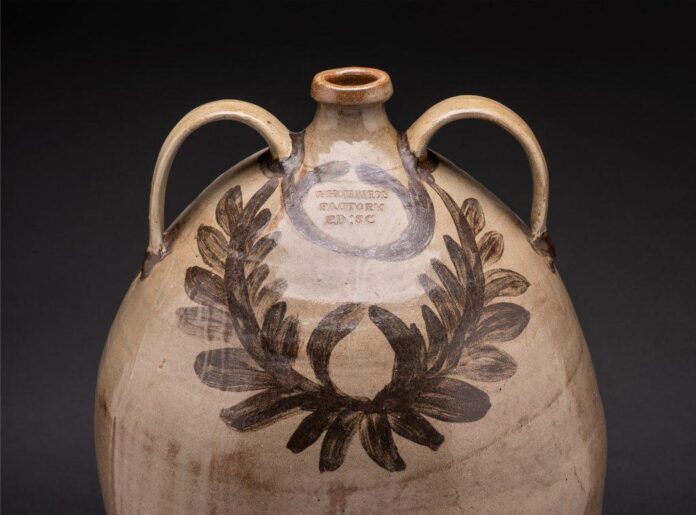The Metropolitan Museum of Art has organized an important exhibition centered around 50 ceramic objects made by enslaved African American potters who were active in westernmost South Carolina during the 19th century.
“In the decades before the Civil War, a successful alkaline-glazed stoneware industry developed in Old Edgefield District, a clay-rich area,” the museum says in a statement. And while common depictions of slavery focus on the backbreaking labor of harvesting cash crops, the exhibition “Hear Me Now,” shows that enslaved people were also highly skilled artisans.
“When I talk to artists about it, they’re still incredulous about the fact that these jars were made, that they survived the kiln firing,” said co-curator Adrienne Spinozzi, an assistant research curator from the Met’s American Wing, of the unique ceramic housewares, which became a lucrative cottage industry in the plantation economy.

by an unrecorded potter, attributed to Miles Mill Pottery (1867–85), Old Edgefield District, South Carolina, alkaline-glazed stoneware with kaolin glaze. Photo: Hudgins Family Collection, New York.
Michigan-based historian Jason Young co-curated the exhibition, contributing years of research and writing about the region’s pottery-rich past. Young also curated a show around Theaster Gates’s engagement with this history, called “The Clay Sermon.” Ethan Lasser, from the Museum of Fine Arts, Boston (where the show travels to next), rounded out the curatorial team.
Planning for the show started in 2017, when the Met acquired a face jug from an unrecorded Edgefield potter for their permanent collection galleries. Spinozzi saw the object as a route to have conversations about “American history and these really difficult and complex and challenging moments in our country’s past.” She then visited South Carolina to do further research.
The exhibition opens with 12 massive jars by David Drake—perhaps the best-known potter from Edgefield. Despite social restrictions against educating enslaved communities, Drake learned to read and write, developing exquisite handwriting, and he carved a wide array of simple literature onto his works, as well as signing and dating them. One jar from June 1834 reads “concatenation,” meaning a system of interconnection. Forty of the jars in the exhibition have similar “verses” carved onto them—sometimes poetic or biblical, sometimes informative (“this jar is for pork”) or even declarative,, proclaiming “I made this.”

Detail of work by Dave, later recorded as David Drake, American, ca. 1801–1870s.
Nineteen regional “face jugs” follow Drake’s works. These vessels, not commercial objects, were shaped to have visages with expressions in high relief. They appeared around 1858, half a century after the transatlantic slave trade had been outlawed, but the same year a ship arrived with 400 captive Africans—100 of which went to Edgefield’s potteries. Many face jugs are believed to resemble minkisi, ritual objects hailing from West-Central African religious practices.
“Hear Me Now” bridges that history with the present moment by including contemporary Black artists who resonate with the Edgefield story, including Simone Leigh, Adebunmi Gbadebo, Woody De Othello, Theaster Gates, and Robert Pruitt.

Theaster Gates, (2020). Courtesy of the artist and White Cube, London
Photo: © White Cube/Theo Christelis.
“As curators, we brought a different set of questions to the material,” Lasser told Artnet News. “We were also conveners, drawing on our own networks to engage friends and colleagues in the act of interpretation.”
Scholarship on enslaved artists from American history has been slim. A team from the Met traveled with a conservator to South Carolina in 2019 to take samples of residue from the vessels’ interiors beyond their prohibitively slender necks. They’re now working with outside experts to learn what these enigmatic face jugs actually held.
“We’re building this database that includes photographs of the interior,” Lasser added. “We’re looking at these objects, looking at their histories, trying to see if we can trace them back to the African American community.”

Storage jar (ca. 1845), by an unrecorded potter, Trapp & Chandler Pottery (1843–ca. 1850), Old Edgefield District, South Carolina, alkaline-glazed stoneware with iron slip. Photo: Courtesy of the Collection of C. Philip and Corbett Toussaint.
“We want viewers to walk away with an appreciation of the full breadth and depth of this fascinating material,” Young added over email. “We want them to connect with the people who created this material, even while living under a harsh regime of American racism and slavery.”
To further this aim, on December 3, the Met will host a public program titled “Learning from Edgefield,” which will have discussions with historians, artists, and museum leaders on the best practices around working with African American cultural heritage sites like Edgefield, and how museums collect, display, and interpret objects by enslaved makers.
“I am most looking forward to the conversations the show opens up,” Lasser said, “about Edgefield and ceramics, enslavement and industry—perhaps even about museums and collecting today.”













![Designer and Artist Christian Louboutin Is Taking His ‘L’Exhibition[niste]’ Show on the Road. First Stop: Monaco](https://usaartnews.com/wp-content/uploads/CnYuGbxzcYrbMKb1HdzMZGAsn5Uq5aMmH0JNsdQS-689x385.jpg)











